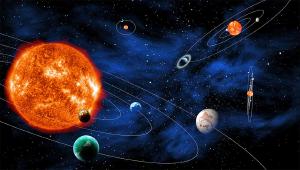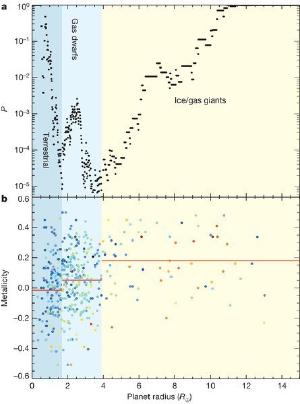Blog
Testing Metal
3 June 2014
 NASA
NASAIn astronomy, all elements other than hydrogen and helium are referred to as “metals.” For this reason, a measure of the amount of other elements a star contains is known as its metallicity. One way to define the metallicity of a star is simply as the fraction of a star’s mass which is not hydrogen or helium. For the Sun, this number is Z = 0.02, which means that about 2% of the Sun’s mass is “metal”. Another way to express the metallicity of a star is by its ratio of Iron to Hydrogen, known as [Fe/H]. This is given on a logarithmic scale relative to the ratio of our Sun. So the [Fe/H] of our Sun is zero. Stars with lower metallicity will have negative [Fe/H] values, and ones with higher metallicity have positive values.When it comes to planetary systems, it’s generally been thought that planets would tend to form around stars with a higher metallicity. At a broad level that makes sense because rocky planets such as Earth can only form in a system where there are enough metals like iron, silicon, carbon and the like. You can’t make a terrestrial planet out of just hydrogen and helium. But now that we’ve discovered lots of exoplanetary systems, we can actually put this idea to the test. A recent paper in Nature has done just that, and they’ve found something rather interesting.1
 Buchhave, et al
Buchhave, et alIn the paper, the authors looked at about 400 stars with exoplanets (about 600 exoplanets in all). They then compared the size of the exoplanets with the metallicity of their stars. What they found was that there was a distinct relation between the metallicity of a star and the type of planets it has. Stars with a metallicity similar to our Sun’s were more likely to have terrestrial planets, while stars with higher metallicity tend to have gas dwarfs, or gas giants (Jupiter-like). The study also showed that high metallicity stars are likely to have so-called “hot-Jupiters”. That is, large gas giants orbiting close to a star.
We’ve seen in computer models how large protoplanets will tend to migrate inward toward the star as they form. This new work would seem to support that idea, since higher metallicity stars would be more likely to form gas giants early on, thus allowing them to migrate inward to become hot Jupiters.
So it seems that metallicity is a significant factor in planetary formation, and higher metallicity stars will tend to form larger planets. But it also seems that stars similar to the Sun are better suited for having terrestrial planets like ours.
Buchhave, Lars A., et al. “Three regimes of extrasolar planet radius inferred from host star metallicities.” Nature 509.7502 (2014): 593-595. ↩︎